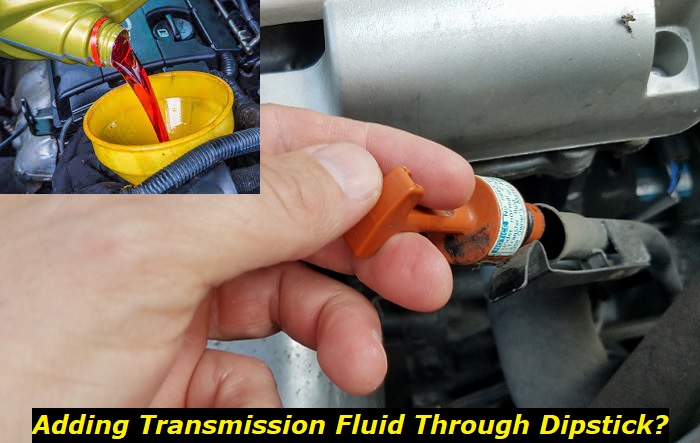If your truck or car has a sealed transmission or is designed without a dipstick, you probably have nothing to worry about as regards changing, checking, or flushing transmission fluid. With older automatic transmissions, it's different. Ensuring the transmission fluid is at an optimal level is necessary for your vehicle to function at its best.
Fluid change in transmissions highlights
- Level of importance:High
- Time interval:Once every 60,000 miles or 10 years (if other not stated by the manufacturer)
- Needed expertise:High
- Needed tools:Basic set of car maintenance tools, plus car lift
- Time taken:2-4 hours
- Possible issues:Fatal failure of your transmission, jerking, harsh work, vibrations, limp mode, no shifting.

Why You should not Add Transmission Fluid Through the Dipstick
The dipstick is not exactly designed to be a fill point for the transmission fluid. It is simply a tool primarily used to check the level of the fluid, rather than to add more. Using it for topping transmission oil can cause several issues, including overfilling, which can lead to costly repairs.
1) Difficult to gauge
One reason why you shouldn't add transmission fluid through the dipstick is that it can be difficult to get the correct amount. If you've ever attempted the practice, you'll agree that it's often hard to gauge exactly how much fluid you're putting in. The result of this difficulty in measuring is often underfilling or overfilling, both of which can cause bigger problems for your car.
2) Messiness
Think about how adding transmission fluid through the dipstick can be messy. Since the dipstick is located inside the engine, any spills or leaks can result in a greasy mess that's difficult to clean up. This can also lead to potential engine damage if the excess fluid seeps into other areas of the car.
3) Risk of contamination
Finally, there's the risk of contaminating the transmission system when you add transmission fluid through the dipstick. This practice can introduce impurities as foreign substances or debris enter the system, potentially causing damage or malfunction.
Contaminants here include dirt, dust, or particles from the environment, as well as oil or other substances that may have been left on the dipstick from previous use. They also affect the thickness and performance of the transmission fluid.
So, if you need to add transmission fluid to your car, use the designated fill point. Not only will this ensure that you're adding the correct amount of fluid, but it will also help to prevent any mess or potential damage to your vehicle.
How to Correctly Add Transmission Fluid
Staying on top of regular fluid changes and replacements is vital for maintaining your vehicle's health. The transmission fluid helps to lubricate and cool the transmission, as well as transfer power from the engine to the wheels. Without it, your transmission could suffer serious damage.
Most vehicles have a dipstick located near the transmission, which some drivers simply remove to pour in the fluid. As explained, this can be a risky practice. What then is the right way to add transmission fluid?
There are several different methods you can try out, depending on the make and model of your vehicle. Here are some to consider:
- Use a funnel:Some vehicles have a small opening at the top of the transmission, which you can access with a funnel. Simply place the funnel in the opening and pour in the recommended amount of fluid.
- Remove the transmission pan:For vehicles without a funnel design, you may need to remove the transmission pan to access the fluid. To do this, begin by removing the bolt at the bottom of the transmission, then take off the pan. Add the recommended amount of fluid and replace the pan.
- Use a transmission flush machine: If you don't feel comfortable performing any of the above methods, take your vehicle to a mechanic who'll use a transmission flush machine to add the fluid. This machine removes old fluid and replaces it with a new one, ensuring that your transmission is properly lubricated and cooled.
No matter which method you choose, keep an eye on your transmission fluid level and replace it as needed to keep your transmission running smoothly.
What Happens if You Put Transmission Fluid in the Wrong Place?
While keeping your transmission fluid levels topped up is critical, it's equally important to make sure you're putting it in the right place. But what happens if you put transmission fluid in the wrong place?
Understand that transmission fluid and engine oil are not interchangeable. They serve different purposes and are designed for different parts of your vehicle. If you put transmission fluid in the engine, it can cause serious damage.
The first thing that will likely happen is that the transmission fluid will be too thin to properly lubricate the engine. This can cause the engine to overheat and potentially seize up, leading to costly repairs or even total engine failure.
Transmission fluid is also not designed to withstand the high temperatures and pressures that engine oil is subjected to. The fluid might break down and create a sludgy, gum-like substance that can clog up your engine's oil filter and passages, leading to further engine damage and reduced performance.
If you accidentally put transmission fluid in the wrong place, act quickly to fix the issue. By catching the mistake early enough, you may be able to simply drain the transmission fluid out and replace it with the correct type of oil.
Signs of Low Transmission Fluid
Knowing how to properly add transmission fluid is one aspect of maintaining your transmission. Another element is ensuring that it has the proper amount of fluid. Without enough fluid, your transmission can suffer serious damage and eventually fail.
So how do you know if you need to add transmission fluid? Here are a few signs to watch for:
- Shifting transmission
If your transmission is shifting gears unexpectedly or slipping out of gear, it could be a sign that it's low on fluid. When there isn't enough fluid, the gears in your transmission can't engage properly, causing these issues.
- Strange noises
If you start to hear grinding, whining, or other strange noises coming from your transmission, the gears might not be functioning properly due to low fluid levels.
- Leak
A puddle of red or brown fluid underneath your vehicle is likely a sign that you have a transmission leak. And if the leak is severe enough, it can result in low fluid levels and potential transmission damage.
- Transmission light is on
Many vehicles have a warning light on the dashboard that indicates a problem with the transmission. If this light comes on, it's a good idea to check your fluid levels and address any issues as soon as possible.
If you're experiencing any of these issues, address the problem as soon as possible. Adding transmission fluid is a relatively simple task that you can do yourself, or bring to a mechanic for assistance.
How Often Should You Replace Transmission Fluid?
Over time, the transmission fluid can become contaminated, leading to problems with your transmission. You should always keep an eye on your transmission fluid levels and refill when necessary. But how often do you need to add transmission fluid?
The answer depends on several factors, including the type of vehicle you drive, the age of your transmission, and the type of transmission fluid you use.
Here's a breakdown of what you need to know:
- Check your owner's manual:The first place to look for information on how often you should add transmission fluid is your vehicle's owner's manual. This should provide specific recommendations based on your make and model.
- Follow a schedule:Most vehicles will require a transmission fluid change every 30,000 to 60,000 miles, although some may go as long as 100,000 miles before needing a change. Stick to this schedule, as letting the fluid get too low or going too long between changes can lead to severe problems with your transmission.
- Watch for warning signs:If you notice that your transmission is shifting poorly, slipping, or making strange noises, it could be a sign that the fluid is low or dirty. In this case, check the fluid level and, if necessary, add more or have a mechanic perform a full flush and refill.
- Consider the type of fluid you use:There are several types of transmission fluids available, including conventional, synthetic, and high-performance. Some of these types may last longer than others, so it's important to choose the right one for your vehicle. Consult your owner's manual or a mechanic for guidance.
Conclusion
While it may seem like a quick and easy solution, adding transmission fluid through the dipstick is something that you should avoid. Instead, always use the designated fill point to ensure the proper maintenance of your vehicle. Also, look out for signs that might indicate low transmission fluid and refill appropriately to keep your transmission operating healthily.
About the authors
The CarAraC research team is composed of seasoned auto mechanics and automotive industry professionals, including individuals with advanced degrees and certifications in their field. Our team members boast prestigious credentials, reflecting their extensive knowledge and skills. These qualifications include: IMI: Institute of the Motor Industry, ASE-Certified Master Automobile Technicians; Coventry University, Graduate of MA in Automotive Journalism; Politecnico di Torino, Italy, MS Automotive Engineering; Ss. Cyril and Methodius University in Skopje, Mechanical University in Skopje; TOC Automotive College; DHA Suffa University, Department of Mechanical Engineering






Add comment